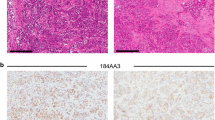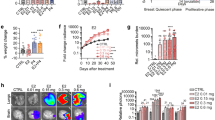Summary
Endocrine therapy is one of the principal treatment modalities of breast cancer, both in an adjuvant setting and in advanced disease. The T61 breast cancer xenograft described here provides an experimental model of the effects of estrogen treatment at a molecular level. T61 is an estrogen receptor positive tumor which was originally derived from a T1N0M0 invasive ductal cancer and has been carried as a serially transplanted xenograft in nude mice. T61 is a hormone sensitive tumor whose growth is suppressed by both estrogen and tamoxifen, in contrast to other estrogen receptor positive tumors such as MCF-7 which are stimulated by estrogen.
Molecular studies have demonstrated that T61 expresses easily detectable levels of mRNA for a number of peptide growth factors, including transforming growth factor alpha (TGF-α) and insulin-like growth factors I and II (IGF-I and IGF-II), but not transforming growth factor beta-1 (TGF-β1). Of these, IGF-II is the only peptide whose expression is altered by endocrine therapy. Treatment of T61-bearing nude mice with physiologic doses of estrogen is accompanied by loss of IGF-II mRNA expression within 24 hours, and rapid regression of tumor. T61 tumor growth is also inhibited in animals treated with a monoclonal antibody which blocks binding of ligand to the IGF-I receptor, which mediates the mitogenic signal of bound IGF-II through autophosphorylation of its intracellular tyrosine kinase domain.
These results demonstrate the utility of the T61 model in the study of the molecular mechanism of estrogen therapy in breast cancer, and suggest that in this system, modulation of a specific growth factor (IGF-II) by endocrine therapy can have profound effects on tumor growth.
Similar content being viewed by others
References
Vignon F, Bouton MM, Rochefort H: Antiestrogens inhibit the mitogenic effect of growth factors on breast cancer cells in the total absence of estrogens. Biochem Biophys Res Commun 146:1502–1508, 1987
Jordan VC: Overview from the international conference on lung-term tamoxifen therapy for breast cancer. J Natl Cancer Inst 84:231–234, 1992
Palshof T: Adjuvant endocrine therapy in premenopausal and postmenopausal women with breast cancer. A report on the Copenhagen Breast Cancer Trials 1975–1987. Medi-book, Copenhagen, 1988
Carter AC, Sedransk N, Kelley RM, Ansfield FJ, Ravdin RG, Talley RW, Potter NR: Diethylstilbestrol: Recommended dosages for different categories of breast cancer patients. JAMA 237: 2079–2085, 1977
Matelski H, Greene R, Huberman M, Lokich J, Zipoli T: Randomized trial of estrogen versus tamoxifen therapy for advanced breast cancer. Am J Clin Oncol 8:128–133, 1985
Beex L, Pieters G, Smals A, Koenders A, Benraad T, Kloppenberg P: Tamoxifen versus ethinyl estradiol in the treatment of postmenopausal women with advanced breast cancer. Cancer Treat Rep 65:179–185, 1981
Ingle JN, Ahmann DL, Green SJ, Edmonson JH, Bisel HF, Kvols LK, et al: Randomized clinical trial of diethylstilbestrol versus tamoxifen in postmenopausal women with advanced breast cancer. N Engl J Med 304:16–21, 1981
Brünner N, Frandsen TL, Holst-Hansen C, Bei M, Thompson EW, Wakeling AE, Lippman ME, Clarke R: MCF-7/LCC2: A 4-hydroxytamoxifen resistant human breast cancer variant that retains sensitivity to the steroidal antiestrogen ICI 182,780. Cancer Res 53:3229–3232, 1993
von Schoultz B, Carlström K, Collste L, Eriksson A, Henriksson P, Pousette Å, Stege R: Estrogen therapy and liver function — Metabolic effects of oral and parental administration. Prostate 14:389–395, 1989
Aro J, Haapiainen R, Sane T, Rannikko S, Pelkonen R, Alfthan O: Effects of orchiectomy and polyestradiol phosphate therapy on serum lipoprotein lipids and glucose tolerance in prostatic cancer patients. Eur Urol 17:229–235, 1990
Henriksson P, Eriksson A, Stege R, Collste L, Pousette Å, von Schoultz B, Carlström K: Cardiovascular follow-up of patients with prostatic cancer treated with single-drug polyestradiol phosphate. Prostate 13:257–261, 1988
Aro J: Cardiovascular and all-causes mortality in prostatic cancer patients treated with estrogens or orchiectomy as compared to the standard population. Prostate 18:131–137, 1991
Ostrowski MJ, Jackson AW: Polyestradiol phosphate: A preliminary evaluation of its effect on breast carcinoma. Cancer Treat Rep 63:1803–1807, 1979
Brünner N, Bastert GB, Poulsen HS, Spang-Thomsen M, Engelholm SA, Vindeløv L, Nielsen A, Tommerup N, Elling F: Characterization of the T61 human breast carcinoma established in nude mice. Eur J Cancer 7:833–843, 1985
Brünner N, Spang-Thomsen M, Vindeløv L, Nielsen A, Engelholm SA, Svenstrup B: Dose-dependent effect of 17β-estradiol determined by growth curves and flow cytometric DNA analysis of a human breast carcinoma (T61) grown in nude mice. Expl Cell Biol 53:220–232, 1985
Brünner N, Spang-Thomsen M, Vindeløv L, Wolff J, Engelholm SA: Effect of tamoxifen on the receptorpositive T61 and the receptor-negative T60 human breast carcinomas grown in nude mice. Eur J Cancer 11:1349–1354, 1985
Jiang SY, Jordan VC: Growth regulation of estrogen receptor-negative breast cancer cells transfected with complementary DNAs for estrogen receptor. J Natl Cancer Inst 84:580–591, 1992
Garcia M, Derocq D, Freiss G, Rochefort H: Activation of estrogen receptor transfected into a receptor-negative breast cancer cell line decreases the metastatic and invasive potential of the cells. Proc Natl Acad Sci USA 89:11538–11542, 1992
Tobin G, Yee D, Brünner N, Rotwein P: A novel human insulin-like growth factor I messenger RNA is expressed in normal and tumor cells. Mol Endocrinol 4:1914–1920, 1990
Brünner N, Yee D, Kern FG, Spang-Thomsen M, Lippman ME, Cullen K: Efffect of endocrine therapy on growth of T61 human breast cancer xenografts is directly correlated to a specific down-regulation of insulin-like growth factor II (IGF-II). Eur J Cancer 4:562–569, 1993
Yee D, Cullen KJ, Paik S, Perdue JF, Hampton B, Schwartz A, Lippman ME, Rosen N: Insulin-like growth factor II mRNA expression in human breast cancer. Cancer Res 48:6691–6696, 1988
Author information
Authors and Affiliations
Rights and permissions
About this article
Cite this article
Brünner, N., Spang-Thomsen, M. & Cullen, K. The T61 human breast cancer xenograft: An experimental model of estrogen therapy of breast cancer. Breast Cancer Res Tr 39, 87–92 (1996). https://doi.org/10.1007/BF01806080
Issue Date:
DOI: https://doi.org/10.1007/BF01806080




